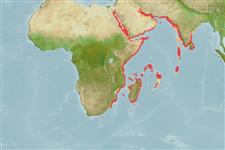Common names from other countries
>
Eupercaria/misc (Various families in series Eupercaria) >
Nemipteridae (Threadfin breams, Whiptail breams)
Etymology: Nemipterus: Greek, nema, -atos = filament + Greek, pteron = wing, fin (Ref. 45335).
Environment: milieu / climate zone / depth range / distribution range
Ecologia
marino demersale; non migratori; distribuzione batimetrica 20 - 450 m (Ref. 100719). Tropical; 31°N - 30°S, 31°E - 99°E (Ref. 3810)
Western Indian Ocean: including the east and west coast of India, Pakistan, Persian Gulf, Red Sea, Gulf of Aden, east African coast, Seychelles and Madagascar, east to Myanmar. A Lessepsian migrant (Ref. 84163). This species has been previously misidentified as Nemipterus mesoprion.
Length at first maturity / Size / Peso / Age
Maturity: Lm 15.6 range ? - ? cm
Max length : 27.0 cm TL maschio/sesso non determinato; (Ref. 124816); common length : 15.0 cm SL maschio/sesso non determinato; (Ref. 3810); peso massimo pubblicato: 330.00 g (Ref. 124816); Età massima riportata: 3.00 anni (Ref. 96857)
Spine dorsali (totale) : 10; Raggi dorsali molli (totale) : 9; Spine anali: 3; Raggi anali molli: 7. Suborbital spine absent. Preopercle with 3 transverse scale rows. Pectoral and pelvic fins very long, reaching to or just beyond level of origin of anal fin. A line drawn up from posterior edge of suborbital reaching the dorsal profile at about 3 to 7 scale rows before origin of dorsal fin. Upper lobe of caudal fin produced into a long trailing light red filament. Axillary scale present. Color: Body silvery pink. Peritoneum salmon-pink.
Benthic on sand or mud bottoms (Ref. 30573). No major fishery exists, but a large population is believed to occur in the Persian Gulf. Minimum depth reported taken from Ref. 127989.
Russell, B.C., 1990. FAO Species Catalogue. Vol. 12. Nemipterid fishes of the world. (Threadfin breams, whiptail breams, monocle breams, dwarf monocle breams, and coral breams). Family Nemipteridae. An annotated and illustrated catalogue of nemipterid species known to date. FAO Fish. Synop. 125(12):149p. Rome: FAO. (Ref. 3810)
IUCN Red List Status (Ref. 130435)
CITES (Ref. 128078)
Not Evaluated
Threat to humans
Harmless
Human uses
Pesca: scarso interesse commerciale
Strumenti
Special reports
Download XML
Fonti Internet
Estimates based on models
Preferred temperature (Ref.
115969): 15.0635 - 24.7625, mean 21.42 (based on 148 cells).
Phylogenetic diversity index (Ref.
82804): PD
50 = 0.5000 [Uniqueness, from 0.5 = low to 2.0 = high].
Bayesian length-weight: a=0.01318 (0.01100 - 0.01580), b=2.95 (2.91 - 2.99), in cm Total Length, based on LWR estimates for this species (Ref.
93245).
Trophic level (Ref.
69278): 3.8 ±0.5 se; based on size and trophs of closest relatives
Resilienza (Ref.
120179): Medio, tempo minimo di raddoppiamento della popolazione 1.4 - 4.4 anni (K=0.83; tmax=3; tm=3.2 Fec=26,091).
Fishing Vulnerability (Ref.
59153): Low vulnerability (18 of 100).
Climate Vulnerability (Ref.
125649): Moderate vulnerability (38 of 100).
